A Coaching Model Created by Scott Berry
(Life Coach, THAILAND)

Phase One – The Power of Awareness
This is a coaching model that aims to apply a cognitive behavioural approach to life coaching. It aims to reduce anxiety, anger and stress. It is designed to be used in one-to-one coaching to help the client gain some freedom from negative feelings and more choice over their mental and emotional state and behaviour.
The coaching is based on a particular hypothesis: that awareness is an incredibly powerful human resource that is always at our disposal. What we know or suspect about awareness is that, when we bring our awareness to something in or about ourselves, we automatically change what we’re focused on. It doesn’t always change immediately or quickly– but it begins to change, just through the process of bringing our attention to it and keeping our attention on it.
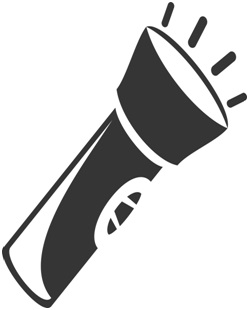 I’ll use the metaphor of a torch to describe this process of things about ourselves that are within our awareness versus things about ourselves that are not in our awareness. Imagine you switch on a torch in a dark room. The light beam is like your awareness. And what is in the beam of light made by the torch is in your awareness. As the beam of light made by the torch, your awareness is fairly narrow. It doesn’t encompass a lot and it cannot hold a great deal within it. But it is highly flexible and you can move your awareness quickly and elastically from one thing to another. Conversely, everything that is in the dark (not in the beam of light made by our torch) is out of our awareness. The further out of the light something is, the more ‘unconscious’ it becomes. Eventually, things become so unconscious that we forget that we’ve forgotten them.
I’ll use the metaphor of a torch to describe this process of things about ourselves that are within our awareness versus things about ourselves that are not in our awareness. Imagine you switch on a torch in a dark room. The light beam is like your awareness. And what is in the beam of light made by the torch is in your awareness. As the beam of light made by the torch, your awareness is fairly narrow. It doesn’t encompass a lot and it cannot hold a great deal within it. But it is highly flexible and you can move your awareness quickly and elastically from one thing to another. Conversely, everything that is in the dark (not in the beam of light made by our torch) is out of our awareness. The further out of the light something is, the more ‘unconscious’ it becomes. Eventually, things become so unconscious that we forget that we’ve forgotten them.
When a feeling, thought, behaviour or mental state is difficult for us to experience, we tend to push it out of our awareness – so that we don’t have to face it or look at it anymore. That part of ourselves becomes less-and-less conscious but it may continue to affect us negatively. The hypothesis here is that, by pushing it out of awareness, we lose power over it. The hypothesis is that once something is deeply ‘unconscious’ we have no way to influence it directly and, in some cases, the thing we’re pushing away gets more control over us (rather than less).
The coaching model I use aims to help clients gain control of anxiety, anger or stress. It is based on this hypothesis that things out-of-awareness have control of us – and that we won’t be able to fix them or influence them until we bring them fully into our awareness. Once in awareness, and with careful coaching support, awareness can ‘do its magic’ and change the pattern in a positive way.
As well as the automatic work of awareness, this model aims to introduce exercises that can assist with one-to-one coaching, that work deliberately to change a client’s mental state for the better. These exercises are designed to put clients in control of anxiety, anger or stress. In the end, the goal is to assist clients to feel free and less controlled by negative emotions.
Step One – Using an Anxiety, Anger or Stress Map
The first part of the model is to start noting a daily rating of the intensity of anxiety, anger or stress. Each day, at the end of the day, you mark the highest level of anger or stress you felt on that day on the map below. Over 7 days, 14 days, 21 days, a month a picture begins to form of the stress pattern in their lives. They will notice that just bringing their awareness to the stress levels they experience, will reduce the levels of stress they actually experience. If they agree, then they complete this map and bring it to coaching every week and we work through the patterns and the client explores remedies to try to reduce the level of anxiety, anger or stress they are feeling, in response to daily experiences.
First, write a number from 1-10 that indicates the level of anger you’re aiming for. 1 is very low-to-no intensity and 10 is very high intensity. Note that 8 and above on a regular basis requires clinical intervention from a psychologist or psychiatrist.
The level of stress or anger I’m aiming for through coach is: __________________
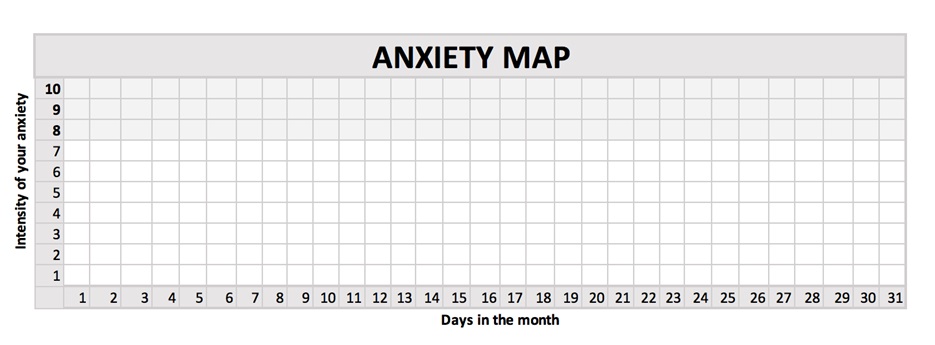
Step two – Using a Daily Diary
The second part of the beginning phase asks clients to keep notes, to ask and answer questions about their levels of stress, anger and happiness each day. The goal here is to be able to link the answers to the questions below to the anger map in step one.
By doing this, clients get to make connections, to see the patterns they’re deploying in themselves and in their lives. The awareness that develops through this process will provide the evidence clients need to make changes in their habits and thinking.
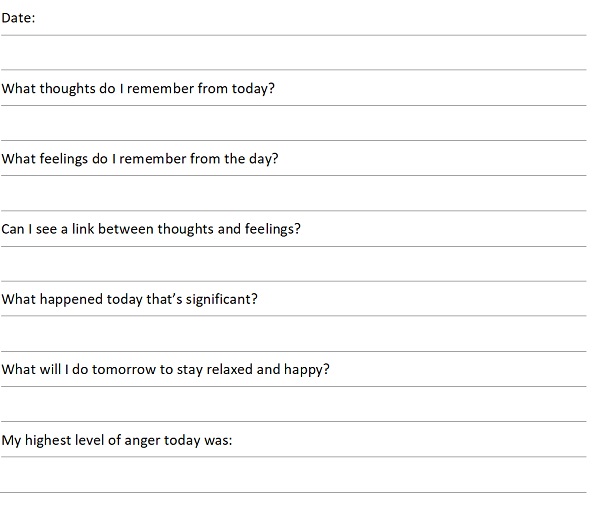
Step Three – Identifying Feelings and Associated Patterns
Feelings of anger may be similar to feelings related to stress but will be vastly different from the other feelings you have in your daily life. Feelings in the “anger family” include but are not limited to anger, fear, worry, bright, being scared, being started, feeling claustrophobic, being overwhelmed and panic. Please tick or check the feelings associated with your anger and stress or discomfort.
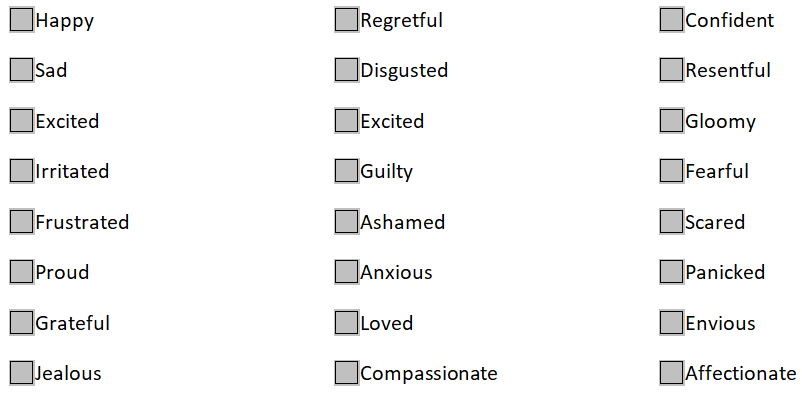
Please provide a narrative description of the connects you’ve noticed between your feelings and your daily life. Look back at the diary and the anger map to see whether there are particular people, situations, thoughts, or other dynamics in play as you feel your highest and lowest levels of discomfort.
Phase Two – Body Language and Facial Expression
Phase Two of the program focuses on facial expressions and body posture. It’s easy to discount body posture, facial expressions and the power they have over thoughts we think and on our moods. The anger or stress we feel seems so overwhelming that a simple change in our facial expression or posture doesn’t feel like it could have much impact. The research tells us that the opposite of this is true.
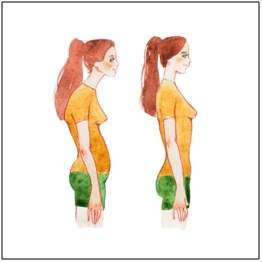 There are multiple studies that show how our body posture, facial expressions and awareness of mood-body-face together can have a powerful effect on our mood. This awareness can help recovery from negative thoughts and moods. It can, over time and with other tools, help to change negative mood ‘complexes’ (this means, regularly dropping into the negative mood as an ongoing habit of behaviour and feeling).
There are multiple studies that show how our body posture, facial expressions and awareness of mood-body-face together can have a powerful effect on our mood. This awareness can help recovery from negative thoughts and moods. It can, over time and with other tools, help to change negative mood ‘complexes’ (this means, regularly dropping into the negative mood as an ongoing habit of behaviour and feeling).
A landmark paper by Amy Cuddy (2010) found that body posture affects the brain’s release of chemicals and hormones that regulate feelings of stress, happiness and confidence. For example, open posture releases more testosterone which helps us feel stronger, confident and competitive. Open posture was found to decrease the stress hormone cortisol. Conversely, closed or slumped posture released more cortisol in the brain and decreased testosterone.
Other studies show that stooping, slumping and hunching over are powerful barriers to getting beyond anger, panic or feeling down. In one study, half the study group were given instructions to stand up straight, change sitting positions, open up the chest and lift the shoulders when they were in a negative mood, while the other half were given no instructions at all. The study found that stooped posture led to move negative thoughts while straightened, open posture led to a change in thoughts and faster recovery from negative moods (2016).
We’ve known for some time that our facial expressions have an impact on others. Research also shows that our facial expressions, and our resting facial expression, has an impact on our own feelings as well (1998). In one study, asking participants to put their face into the expression of a particular feeling induced that very feeling. In another study, facial expression affected body temperature and the flow of blood to the brain (Goleman 1989). While there’s lots more research needed to clearly understand how best to use this knowledge to improve mood, it’s clear that positive or negative feelings are amplified and even caused by, our facial expressions.
In this phase of our work, we’re changing your thinking about the body and the face. We often think like this: “I’m sitting this way or my face is this way because I’m feeling sad or stressed or anxious.” But what if we rethink this idea? What if we think this way instead: “I’m feeling sad, or stressed or anxious in part because of the way I’m sitting and my facial expression.”
Step Four – Identifying and Using Facial Expressions
Some people are good at expressing their feelings and being aware of their bodies and feelings and how they’re connected. Others have difficulty with this. The first thing they may need to do, to become a master of stress reduction is to get more conscious control of their feelings by identifying their own body and facial expressions.
Take a look at these pictures and think about the sorts of facial expressions you ‘wear’ when you’re anxious or stressed. Use the face sheet to pick out several emotions that seem to describe best what you experience when are feeling anxious or stressed.
Exercise 1 – Facial Awareness
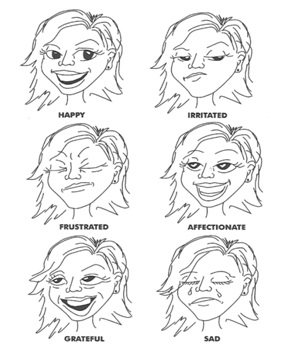 Bring your awareness to the facial expressions you wear over the coming five days. Notice the facial expressions you ‘wear’ during different social situations. For example, when you are in a meeting, in supervision with a subordinate or manager, with family or friends. Notice the facial expressions you ‘wear’ during happy feelings and during feelings of anger or stress. Make a list and bring the list to coaching to discuss it.
Bring your awareness to the facial expressions you wear over the coming five days. Notice the facial expressions you ‘wear’ during different social situations. For example, when you are in a meeting, in supervision with a subordinate or manager, with family or friends. Notice the facial expressions you ‘wear’ during happy feelings and during feelings of anger or stress. Make a list and bring the list to coaching to discuss it.

Exercise 2 – Smiling Practice
Practice smiling non-stop for 2 minutes a day (start at 1-minute a day if you need to but do it twice a day). As you smile to notice the thoughts you think and the feelings you have. Notice what happens to any negative thoughts or worries you have as you smile. What you’ll learn is that your body, body posture, face, facial expressions are part of your mind: you have to be aware of your body and your face if you want to become a masterful interrupter of your own stress, anger or anger patterns.
Step Five – Identifying and using Body Posture
Just like with facial expressions, some people are good at being aware of their bodies and their feelings. The next thing clients may need to be able to do to become a master of stress reduction is to get more conscious control of their feelings and to identify their own body posture or physiology.
Take a look at these pictures and think about the sorts of body postures you adopt when you’re anxious or stressed. Use the body sheet to pick our several emotions that seem to describe best what you experience when are feeling anxious or stressed.
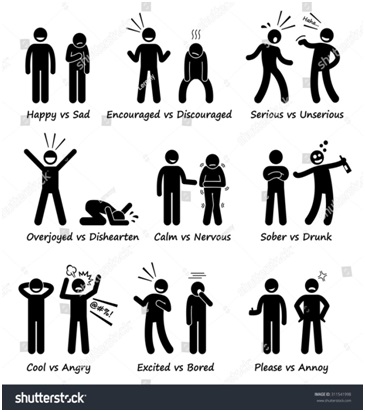
Exercise 3 – Body Awareness
Bring your awareness to your body over five days. Notice the body postures you assume in different situations. Notice what body postures you assume under stress. E.g. when you are in a meeting, in supervision with a subordinate or manager, with family or friends. Notice also where you hold tension in your body when you’re anxious or stressed. For example, in your jaw, your shoulders, your hips. Notice where you ‘feel’ the stress. E.g. tightness in the chest, butterflies in the stomach or being up on your toes in moments of difficulty. Make a list and bring the list to coaching to discuss it.

Exercise 4 – Meditation, Yoga and Exercise
All of this work on your body and face may start you thinking about how you can use exercise and meditation to impact and improve your self-awareness, your feelings of well being and posture. Take some time to decide how you can use the resources around you to engage in more exercise and meditation.
Step Six – Triggers for Anger and Stress
It is true that some people are a little more “high strung” than others. People worry about different kinds of things. Some people appear to be in a nearly constant state of stress while for others stress is triggered by people, places or things or sometimes by something less obvious. Either way, there are times when we feel more stressed than others and times when we feel less stressed than others.
Take a few minutes to answer the following questions that may give you a window into your triggers for stress:
To me, anger or stress means:
I seem to feel the most stressed or anxious when:
The last time I noticed feeling this way was:
Themes at the times I feel “worked up” include:
Things that seem to happen right before I feel stressed or anxious are:
My triggers for stress or anger are:
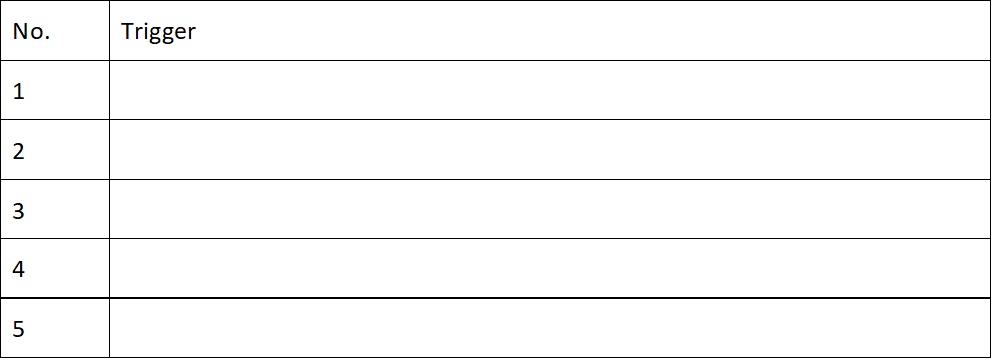
Phase Three – Cognitive Behavioral Coaching
Phase three of the program introduces cognitive behavioural coaching. CBC is based on the principle that thoughts influence feelings, feelings influence actions, and actions influence our results or life circumstances. Situations don’t make us feel certain ways. People don’t make us feel certain ways. It’s how we interpret (or think about) situations or things people say or do that influences how we feel.
So, a simplified, linear version of the model of cognitive behavioural coaching looks like this:
Event > Thoughts > Feelings > Actions > Results
The question to ask yourself is: “Where in this sequence can I intervene directly to impact the end result?”
Do I choose or can I influence events in my life?
Sometimes. Sometimes we put ourselves in situations that make us vulnerable to certain triggers. E.g. we choose who we date, whom we marry, whether we go to certain parties or hang with certain people, whether we stay at a job or leave it. And sometimes we don’t. We don’t choose our parents, siblings, situations our caretakers put us in when we are young, who are driving on the road, or natural disasters. We have a say regarding some of the events (triggers) we experience, and others are completely out of our control.
Do I choose my thoughts and feelings?
To answer this question let’s try an exercise. As you are reading this: Picture a giraffe. Can you do it? Now picture a snowflake. Can you see it? Picture yourself in your best friend’s house. Can you conjure up these images? Of course, you can. Now feel enraged. Just feel it. Can you do it? What did you have to do to feel enraged? You had to think about something that would get you there. Regardless of what you thought, the point is that it’s almost impossible to command our feelings. But we can command our thoughts.
We don’t and can’t choose all of our thoughts. Some thoughts “just come” and the clinical term that is automatic thoughts. We all have them. Once they come, we can get better at increasing our awareness of them, paying attention to them, and working to change them through the tools you’re learning here in this workbook.
What is the difference between thoughts and feelings?
Thoughts are not feelings. A lot of people say, “I felt like he was scheming against me.” But that is not a feeling – it is a thought. That type of thought often leads to feelings.
But here’s the difference: If it’s a full sentence it’s a thought. Feelings are one word that expresses an emotion – like angry, sad, mad, happy, excited, fearful, anxious, overwhelmed, panicked and annoyed. It is the content of our thoughts that determines what types of emotions we feel.
We can’t always change our circumstances. But we can change our response to them. This is why two different people can go through the exact same life event and come out with a vastly different experience of it.
What we’re going to do in this phase is to determine what beliefs and “distorted” thoughts lead to your feelings of anger and stress.
Step Seven – Beliefs, Thoughts, Feelings & Behaviours
In this exercise, you are asked to tick the box next to the statement or comment that applies to you when you’re feeling anxious or stressed.
First, you’re asked to describe the beliefs you have when you’re anxious or stressed.
Next, you’re asked to link the beliefs you have to ‘thought distortions’ (unhelpful thoughts that escalate your anger or stress).
You’re then asked to list any automatic thoughts you have, along with feelings associated with them and the reactions or behaviour that this all leads to.
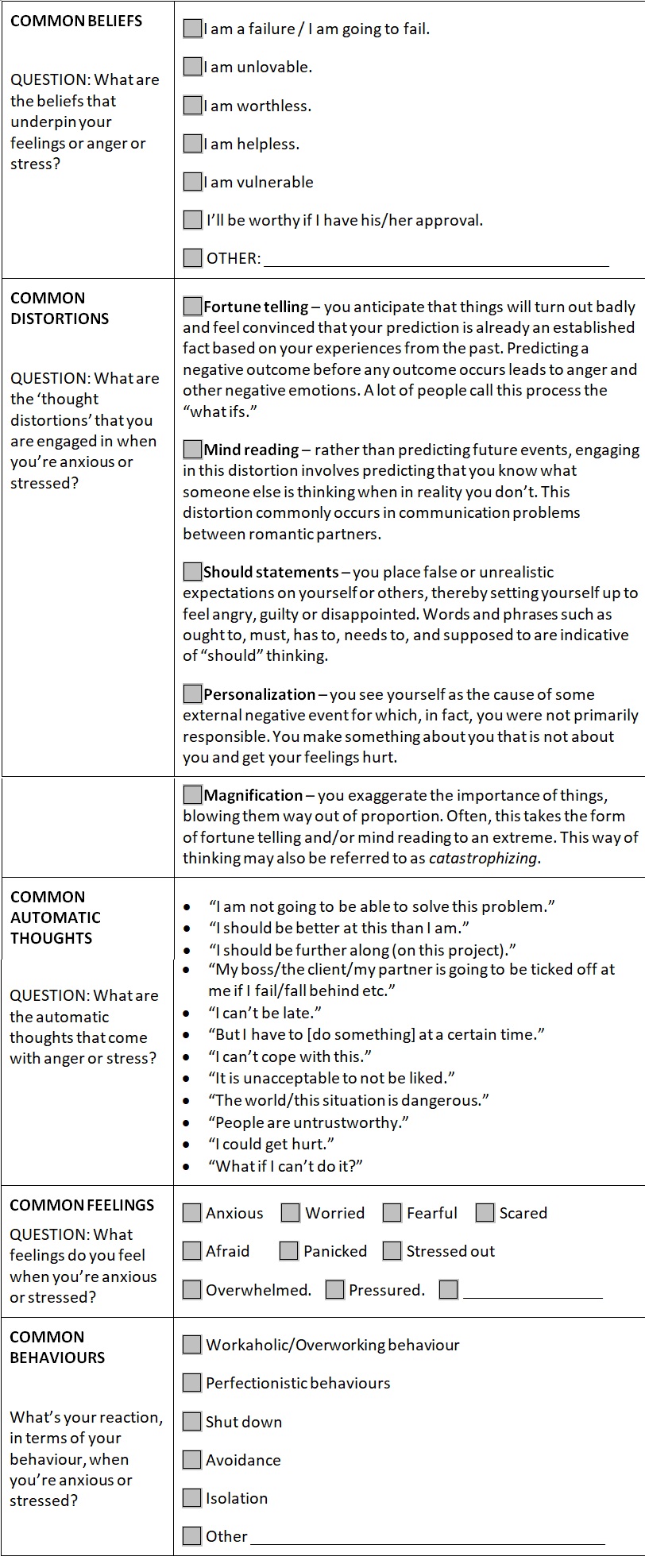
Step Eight – Identify Unhelpful and Helpful Beliefs
Beliefs come in pairs. Unhelpful beliefs might also be called unhealthy beliefs because they don’t feel better and live happily. I use a pac-man image for unhelpful beliefs because these beliefs tend to accumulate negative experiences and apply negative meanings to experience in order to feed themselves. For each unhelpful belief, you identify, formulate in your own words what the exact opposite of that would mean to you.
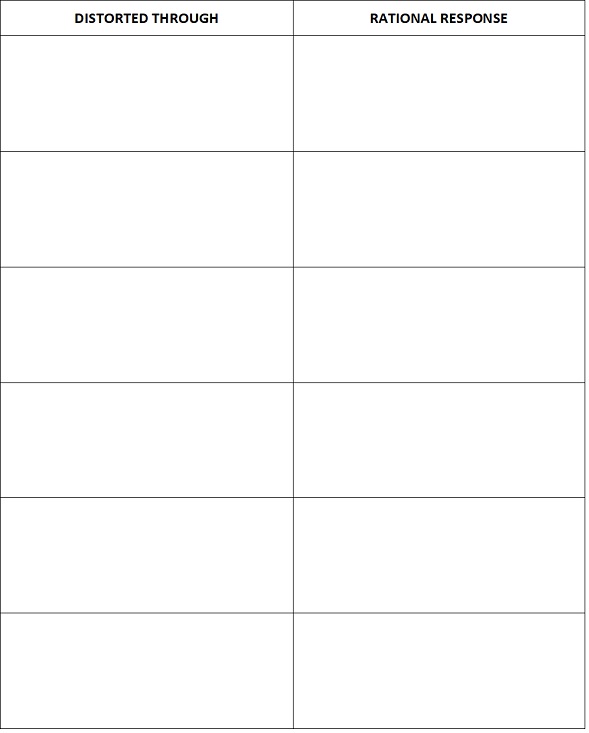
Step Nine – Distorted Thoughts and Their Opposite
Challenging distorted thoughts doesn’t always make them go away. However, it can energize enough internal challenge that the feelings from these thoughts aren’t quite so intense. Repeating rational responses is a helpful way to challenge distorted thoughts.
Acknowledgements and References
The content in this document has been sourced and derived from the following texts:
- The Anxiety ToolKit by Alice BoyesPhd.
- How to Make Anyone Like You by Leil Lowndes.
- The CBT Toolbox by Jeffrey Riggenbach PhD.
- Coaching with NLP by Joseph O’Connor and Andrea Lages.
- How to Feel Confident by Leil Lowndes.